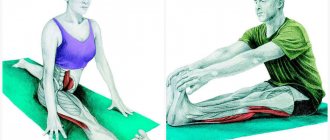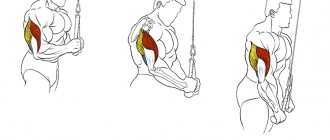There is an opinion that reverse hyperextension has moved beyond the category of simple exercises aimed at recovery after training.
Fitness trainers claim that this exercise will protect your spine. This is a serious statement, but what hyperextension is actually needed for and how to do it correctly, you will learn in this article.
Reverse hyperextension is an exercise (and machine) that will reduce stress in the lower spine and strengthen the hamstrings, glutes, and quads.
It is usually performed at the end of a heavy workout (especially those involving squats and deadlifts) or as an assistance exercise to strengthen the back muscles.
Here you will learn the correct technique for performing reverse hyperextension on a special machine, fitball, regular bench, and even on the floor.
An alternative to the machine can be a bench press bench or any durable surface like a table.
Pros and cons of the exercise
In fitness, reverse extensions are one of the most beneficial exercises. It is aimed at developing the muscles of the lower back.
The main benefits of the reverse hyperextension exercise:
- Prevention and strengthening of the lower back.
- Preventing the occurrence of intervertebral hernias and other problems in the lumbar region.
- Preparing the back for heavy basic exercises (prevents slowing down progression due to a limiting weak lower back).
Reverse extensions are recommended for anyone who spends long periods of time in a sitting position. This helps keep your back muscles toned and avoid subsequent problems.
disadvantage of hyperextension is the incorrect execution technique. Any mistakes when performing this movement can not only reduce its benefits, but also increase the risk of injury.
How to avoid getting injured
Although this type of training is one of the safest, there are several safety rules when performing it. First, always check the stability of the bench or other surface you choose to rest on. Secondly, make sure that your back always remains straight. Frequently performing reverse hyperextensions with a rounded back can lead to poor posture.
Important! Make sure you breathe correctly: inhale when moving your legs down, exhale when lifting. Holding your breath is prohibited!
Common Mistakes
- Don't do reverse hyperextensions by jerking, as this can hurt your back.
- Before using weights, we recommend that you carefully practice the technique without weights.
- Do not bend your legs - the effectiveness of the exercise decreases sharply
What muscles work
With the basic technique of performing reverse hyperextension, the work includes:
- Spinal extensor muscles.
- Gluteal.
- Biceps femoris.
The abdominal and arm muscles also work in static mode They provide stabilization of the body.
Workout at home
Not always and not everyone is able to train in the gym. This is due to the following reasons:
- Lack of time to travel to the fitness center.
- Insufficient funds to pay for a subscription, and even more so, for training under the supervision of a coach.
- Complexity due to large crowds of people and shortcomings of one’s own body.
But there is always a way out, if a person really wants to train. It is then that a person looks for opportunities for alternative training and finds it. One option is to study at home. They are divided:
- Classes in the yard, on the sports ground in the warm season.
- Training in an apartment, in a country house or in your own home.
While on the street, on the sports ground you can use (if any) two horizontal parallel pipes located at the same height. You need to lie with your body (across) on them so that your legs hang down freely, holding tightly with your hands to one of them. The technique is the same.
The only negative is that such a projectile is somewhat stiff, and for comfort you need to throw something soft over it.
At home, you can use a couple of chairs, a sofa, a bed or a bench, if you have one.
In the end, you can also practice on the floor, as already mentioned.
Unlike direct hyperextension, an athlete can do without an assistant, although the presence of one creates a certain athletic fervor and a spirit of healthy competition. So we can say with confidence that hyperextension at home is not only possible, but also widely applicable.
Train with a fitball
A fitball is a special ball for performing reverse hyperextension. How to do the exercise:
- You need to lie down with your stomach so that the pelvic part is located in the center of the ball.
- You can hold onto anything with your hands, from heavy dumbbells or weights to a wall bars (if you have one), or the same central heating radiator, pipe, etc.
- The starting position is relaxed, lying on the ball and holding onto reliable support with your hands.
- While inhaling, you need to smoothly raise your legs while simultaneously stretching the toes of your feet. This is how the maximum leg lift is done.
- When lowering your lower limbs, it is important not to relax completely, but only to touch the floor with your toes - the body in this position is a straight line.
The speed of the exercise should coincide with the speed of measured breathing. 5-7 repetitions with two or three approaches will sufficiently work the necessary muscles.
Switching reverse hyperextension to glutes
Trying to switch the load on the hamstrings and buttocks (as girls sometimes do) in a reverse hyperextension machine is a very justified option. In the case of lifting the body rather than the legs (the usual version of the exercise), the load falls more on the lower back. By changing the load on the buttocks in reverse, the exercise will improve the development of this area. But the lower back will receive less load. Therefore, reverse extension should be done in cases where the development of the gluteal muscles is required first. When the main task is to maximally work the lower back, it is recommended to choose classic hyperextension.
Execution Variations
There is a special simulator for this exercise, but it is not very common in modern gyms. Therefore, the question often arises about what can replace the reverse hyperextension machine. In fact, this exercise can be performed on any surface that allows you to achieve the desired body position.
There are such variations:
- on fitball;
- on a bench at an angle of 45°;
- with leg bending.
Reverse hyperextension technique: 6 options
There are many different variations for this exercise. They allow you to perform reverse hyperextension at home and in the gym with equal effectiveness. Choose the option that best suits your goals.
Reverse hyperextension in the simulator
The classic version is aimed at training the lower back. Although the glutes and hamstrings are also included in the work, they are not the dominant groups.
Technique:
- Lie your body on the machine and grab the handles (or any other support) with your hands. The legs should be down in the starting position.
- Begin to raise your closed legs together so that they rise slightly above parallel to the floor.
- Without pausing, return your legs down and repeat the movement.
Exhale when lifting your legs up, inhale when lowering them. It is extremely important that the pads of the exercise machine are located in the lower abdomen. This allows you to perform the exercise correctly and correctly fixes the body.
Reverse hyperextension on a bench
Typically, reverse hyperextension on a bench is performed in cases where the gym does not have the necessary equipment. The exercise has the same features and technique as the usual version in the simulator, differing only in a shortened range of motion.
Technique:
- Lie down on the bench so that its edge is in the lower abdomen (just above the groin area). Hug her tightly, fixing your hands on the bottom of the bench. Legs are brought together.
- Begin to lift your legs up, bringing them slightly above parallel to the floor.
- At the top point, take a minimal pause, then return to the starting position.
It is important not to lower your feet to the floor so that the tension is maintained throughout the entire approach. Otherwise, the exercise will significantly lose its effectiveness (this option is used only during rehabilitation, to strengthen the lower back and minimize long-term tension in the problem area).
Reverse hyperextension in Smith (bar leg push)
This is a version of the reverse glute hyperextension. Using it to train the lower back is ineffective, since the load is redistributed to the gluteal region. It is considered the most powerful version of the exercise due to the use of large weights.
Technique for performing reverse hyperextension in Smith:
- Lie down on the bench and grab it tightly with your arms. Bend your knees at a right angle and place your foot on the barbell.
- Start pushing the bar up as high as possible.
- Pause at the bottom, then lower your legs to the starting position.
It is important to remember that the excessive hyperextension in the lower back that occurs in this movement can negatively affect the health of the spine. Therefore, this version should be approached gradually, with a sufficiently trained lower back and after a thorough warm-up. Also, this movement cannot be performed without a partner (his role is reduced to belaying, removing and installing the bar on the safeties).
Reverse hyperextension in the lower block of the crossover
Another option that is more designed for pumping the buttocks . For it to be effective, it is important to understand which muscles work in reverse hyperextension in a standing position. With this technique, the back takes minimal part, the main load falls on the buttocks and hamstrings. Therefore, it is important to perform this movement on leg day, not back day.
Technique:
- Set the appropriate weight in the block.
- Attach the cuffs to your ankles and lie on your stomach on the bench upside down at a 45-degree angle.
- Begin lifting your legs as you would in a normal reverse hyperextension.
- Pause briefly and return your legs to the starting position.
In one set, you need to perform a series of 10-12 repetitions for each leg.
Option for reverse hyperextension at home
For this option, any table, sofa or other surface that will allow you to securely fix the case is suitable. This option is as close as possible to the bench technique due to the shortened amplitude.
Technique:
- Fix the body on the surface and hold onto any support with your hands. Place your feet on the floor and bring them together (with minimal bending at the knees).
- Start raising your legs at a moderate pace as high as possible.
- Without pausing, lower your legs to the starting position and repeat the movement.
It is important to keep your feet on the floor to maintain tension in the target area.
Reverse hyperextension on a fitball
The reverse hyperextension option on a fitball is one of the most health-improving. Due to unstable support, additional muscles are involved in the work. There is also a version in which the fitball is clamped with the feet, but it is significantly less effective (due to the strong separation of the legs).
Technique:
- Lie on your stomach on the fitball. Place your hands on the floor or grab any support. Legs are brought together.
- Start raising your legs, bringing them as high as possible.
- Without pausing, return to the starting position and repeat the movement.
Secrets of exercise effectiveness
Like all back muscle development exercises, reverse hyperextension requires a strong mind-muscle connection. The effectiveness of the training will directly depend on the athlete’s ability to concentrate on the work of the target muscles at each point of the trajectory. Mechanical execution of movements, as well as lifting the legs due to jerks and inertia, will not give results. It is especially important to prevent muscle relaxation at the lowest point.
Sudden movements and haste in this exercise are inappropriate and can cause injury. Each movement is done smoothly and under control: the legs are lowered by 4 counts, raised by 3.
When training, it is important to avoid straining your neck. Your head should be kept straight, without tilting back.
A
The specificity of the starting position in this exercise somewhat restricts breathing, but despite this, you should try to inhale when lowering your legs, and exhale powerfully while lifting.
When the correct technique is mastered and it becomes easy to perform the required number of repetitions, it’s time to complicate the task by using weights. You can practice this way in different ways, let’s look at which ones:
- the use of special weights attached to the legs;
- placing a fitball between the legs;
- holding a dumbbell of the required weight between your feet;
- training on a bench installed in a block simulator. Cuffs with carabiners connected to a block are attached to the legs. The load is set depending on the physical capabilities of the athlete.
Getting a stability ball or dumbbell into position can be challenging at first. Until the skill is developed, it is advisable to use the help of a partner.
m
After completing the last repetition with weights, you can lower the dumbbell or ball to the floor and “finish off” the muscles without weight.
The “Scorpion Tail” is a universal exercise that involves different ways of being included in training programs:
- since training the back extensors in this version does not “clog” the back, it is advisable to perform it before heavy basic exercises (it is preferable to transfer classical hyperextension to the final stage of the lesson);
- reverse hyperextension can also be done at the end of training to “finish off” the target muscles;
- Some athletes use the “Scorpion Tail” in supersets for core development, practicing the principle of combined development of antagonist muscles.
Reverse hyperextension does not have to be included in any training routine. It can be done as an independent exercise if you need to normalize the condition of your back, as well as before or after basic movements.
Recommendations
Reverse hyperextension is usually performed on the day of back training. Pre-warmed muscles will help avoid injury and make the exercise more effective.
The number of sets and repetitions depends on your fitness level and training goals. However, to strengthen and develop the lower back, a rep range of 12-15 is recommended. The option of performing it until muscle failure is also well recommended (use it when pumping up the lower back after identifying hernias or other problems).
Taking into account the specifics of the lumbar zone, it is enough to do 3-4 sets in one workout. To pump the area - 5-6 approaches.
Benefits of Exercise
The Scorpio Tail is based on technically simple movements that can be performed in the gym or at home.
By regularly doing reverse hyperextensions, the athlete strengthens the back extensors, which support and protect the spine. Unlike the classic version, the load here is divided between the back, legs and buttocks, so the athlete can work with weights, increasing them with minimal risk of injuring the spine. This promotes more effective development of the target muscles and a noticeable improvement in posture.
This exercise is suitable for inclusion in the training plan of any athlete, regardless of training level and gender. By strengthening the spinal erectors, it will help increase performance in heavy compound movements: squats, deadlifts, standing presses.
The “scorpion tail” is especially recommended for those who are recovering after a long break from training. If until recently a beginner spent most of his time in an office chair, he should begin his training journey not with pumping up his biceps, but with preparing his back for the upcoming loads. Reverse hyperextension will strengthen the muscular corset of this area and help avoid injury.
With
Exercise in this version is indispensable for everyone who leads a sedentary lifestyle, for those suffering from pain and back tension due to inactivity. This training helps restore blood circulation in the lumbar region, having a rehabilitative effect on this area.
By doing reverse hyperextension, girls get the opportunity to qualitatively work out their “favorite” muscle areas - the back of the thighs and buttocks, while simultaneously acquiring beautiful posture and a strong back.
Content
- Step-by-step description of the classic technique
- How to properly perform hyperextension for the back?
- How to properly exercise on a hyperextension machine:
- Features of performing hyperextension on the buttocks and back
- Common mistakes in hyperextension technique
- Options for performing hyperextension Reverse hyperextension
- Hyperextension with weights
- Lateral hyperextension
The main load falls on the back extensor muscles - the long muscles along the spine, the gluteus maximus and the hamstrings. The exercise is suitable if you train at home, as it can be performed without special equipment.











